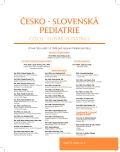Nonhealing atopic eczema
Authors:
J. Micherová 1; T. Matějek 1; K. Kamarádová 2; J. Bartoňová 3; K. Švojgr 4
Authors‘ workplace:
Dětská klinika LF a FN, Hradec Králové
1; Fingerlandův ústav patologie LF a FN, Hradec Králové
2; Klinika nemocí kožních a pohlavních LF a FN, Hradec Králové
3; Klinika dětské hematologie a onkologie 2. LF UK a FN Motol, Praha
4
Published in:
Čes-slov Pediat 2017; 72 (6): 352-360.
Category:
Case Report
Overview
Langerhans Cell Histiocytosis (LCH) is a rare disease with a variable clinical presentation and prognosis. The authors present a case report of 11month old boy with LCH. The patient had skin symptoms from his birth that were considered to be a neonatal toxoalergic rash, and then subsequently, to be a seborhoic dermatitis, atopic eczema and perianal intertrigo. He suffered from recurrent respiratory tract infections and since the age of six months, he had secretion from his both ears, treated as an external otitis. Shortly before the correct diagnosis of LCH was assigned, the patient developed anemia, trombocytopenia and neutropenia. The multi-system LCH also affected other risk organs - liver and spleen. The therapy began with vinblastine and prednisolone according to the international protocols for treatment of LCH. The disease did not responed to standard induction therapy, so an experimental treatment with BRAF inhibitor was commenced with a prompt response and regression of symptoms.
The article focuses on the description of symptoms of LCH with an aim to raise awareness of the disease, to prevent delayed diagnosis, which can happen due to confusion of symptoms of other more common diseases.
KEY WORDS:
Langerhans cell histiocytosis, infant, multisystemic form, BRAF V600E, vemurafenib
Sources
1. H’eritier S, Emile J, Barkaoui M, et al. BRAF mutation correlates with high-risk Langerhans cell histiocytosis and increased resistance to first-line therapy. J Clin Oncol 2016; 34 (25): 3023–3030. doi: 10.1200//JCO.2015.65.9508.
2. Hutter C, Minkov M. Insights into the pathogenesis of Langerhans cell histiocytosis: the development of targeted therapies. Immunotargets Ther 2016 Oct; 12 (5): 81–91.
3. Morimoto A. Recent advances in Langerhans cell histiocytosis. Pediatr Int 2014; 56: 451–461.
4. McClain KL, Boxer LA, Park JR, et al. Clinical manifestations, pathologic features, and diagnosis of Langerhans cell histiocytosis. https://www.uptodate.com/contents/clinical-manifestations-pathologic-features-and-diagnosis-of-langerhans-cell-histiocytosis, 2016.
5. Minkov M, Rodriguez-Galindo C. LCH-IV International Collaborative Treatment Protocol for Langerhans Cell Histiocytosis. https://histiocytesociety.org/pages/2011-hs-lch-iv.
6. Jarkovská R, Timr P. Histiocytózy. Pediatr praxi 2013; 14 (5): 303–306.
7. Ladisch S. Langerhans cell histiocytosis. In: Nelson´s Textbook of Pediatrics. 11th ed. Philadelphia: Saunders, 2015: 2484.
8. Lebl J, Janda J, Pohunek P, Starý J. Histiocytóza z Langerhansových buněk. In: Klinická pediatrie. Praha: Galén, 2012: 579–580.
9. Lanzkowsky P. Langerhans cell histiocytosis. In: Manual of Pediatric Hematology and Oncology. 5th ed. Elsevier, 2011: 567–585.
10. Haupt R, Minkov M, Astigarraga I, et al. Langerhans cell histiocytosis (LCH): Guideline for diagnosis, Clinical work-up, and treatment for patients till the age of 18 years. Pediatr Blood Cancer 2013, 60: 175–184.
11. Windebank K, Nanduri V. Langerhans cell histiocytosis. Arch Dis Child 2009; 94: 904–908. http://adc.bmj.com.
12. Morren M, Vanden Broecke K, Vageebergen L, et al. Diverse cutaneous presentations of Langerhans cell histiocytosis in children : A retrospective cohort study. Pediatr Blood Cancer 2016; 63: 486–492.
13. Merglová V, Hrušák D, Boudová L, et al. Langerhans cell histiocytosis in childhood - Review, symptoms in the oral cavity, differential diagnosis and report of two cases. Journal of Cranio-Maxillofacial Surgery 2014; 42: 93–100.
14. Simko S, Garmezy B, Abhyankar H, et al. Differentiating skin-limited and multisystem Langerhans. J Pediatr 2014; 165 (5): 990–996.
15. Haroche J, Cohen-Aubart F, Jean-Francois E, et al. Dramatic efficiency of vemurafenib in both multisystemic and refractory Erdheim-Chester disease and Langerhans cell histiocytosis harboring the BRAF V600E station. Blood 2013; 121: 1495–1500. htpp://dx.doi.org/10.1182/blood-2013-07-446286.
16. Heaney LM. Saving orphans: BRAF targeting of histiocytosis. Blood 2013; 121: 1487–1488. http://dx.doi.org/10.1182/blood-2013 -01-475962.
17. Egeler RM, Katewa S, Leenen P, et al. Langerhans cell histiocytosis is a neoplasm and consequently its recurrence is relapse. Pediatr Blood Cancer 2016; 63 (10): 1704–1712. doi: 10.1002/pbc.26104
18. Héritier S, Jehanne M, Leverger G, et al. Vemurafenib use in infant for hight risk langerhans cell histiocytosis. JAMA Oncol 2015; 1 (6): 836–838. doi: 10.1001/jamaoncol.2015.0736.
Labels
Neonatology Paediatrics General practitioner for children and adolescentsArticle was published in
Czech-Slovak Pediatrics

2017 Issue 6
Most read in this issue
- Holoprosencephaly – case report
- Physical activity guidelines for Slovak children and youth (6–18 yr.)
- Nonhealing atopic eczema
- The specific care about children born with assisted reproduction
